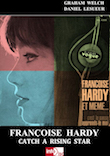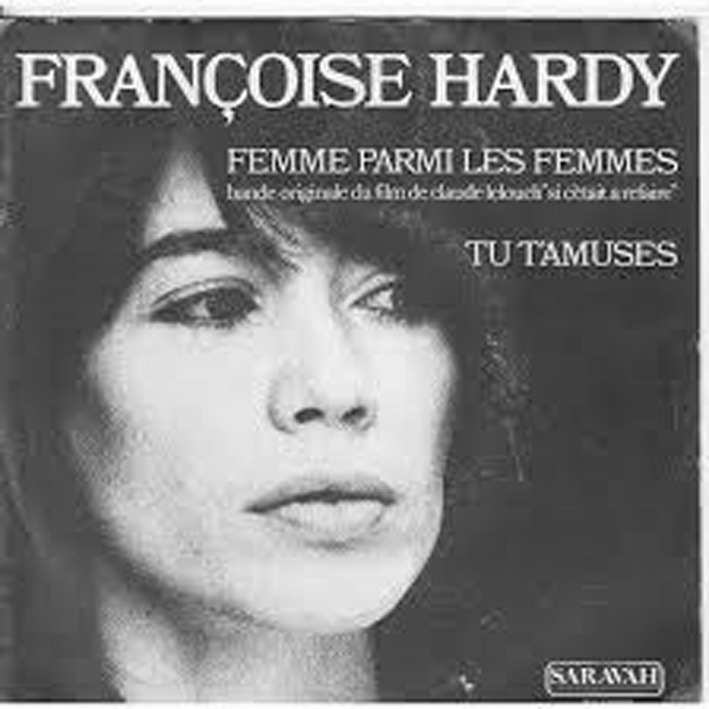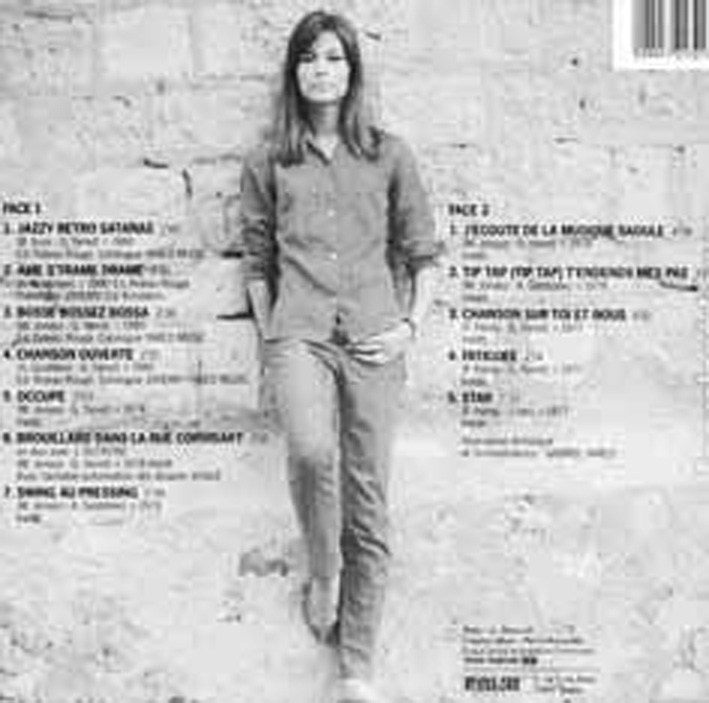- Françoise Hardy : Has Right Come To Town


Sanson had left him for Stephen Stills just weeks before their planned wedding and Gall wouldn’t come into his life for another couple of years. (La Déclaration D’Amour was the song that brought Gall back to into the spotlight after six years away from the French charts. Interestingly, Hardy chose to cover the song for a radio performance in 1975, and it was included on the 40th anniversary re-release of Message Personnel.) Hardy admired Sanson’s work greatly. “Véronique Sanson’s first album... bowled me over on many levels... The originality of the tunes, the lyrics, the production and the singing were such that all the [other] French female singers seemed old hat, including me.” (Le Désespoir Des Singes... Et Autres Bagatelles).
Her admiration prompted the contract-less Hardy to get in touch with Claude François’ Flèche record label. The company’s Jean-Marie Périer introduced her to Michel Berger, a man for whom she felt such admiration that she wouldn’t have dared to approach him off her own bat. “She has decided to approach her future records under the guidance of a producer.
Michel Berger will be the first. ‘It was the first time I had worked with someone who takes all the responsibility on his shoulders and with whom there is a relationship where one is dominant (the producer) and one dominated (the artist).’” (Paroles Et Musique Nouvelle Série no. 9).
In the end, Hardy was disappointed and the collaboration went no further than one 45, Je Suis Moi.
Although overworked, Berger had nevertheless agreed to produce what Hardy has described as a “disparate and unequal” album. He did so because he had written two songs for it and had played them to Hardy, seeking her approval. As it turned out, both were lifted from the album for the only single to be issued from it (Warner Bros WEA 16 331). Françoise loved the first one when she first heard it, even though it had no title at the time.
She became anxious, however, when Berger explained that he would like to add a spoken passage to it: “The sound of her voice is particularly interesting... I wanted Françoise to take part more, that it really reflected her personality.” (Étienne Daho and Jérôme Soligny, Superstar et Ermite, Jacques Grancher éditeur, 1986).
She was invited to write the spoken passage, so it’s thanks to the interpreter, and not to the composer, that Message Personnel became such a success. (Hardy also recorded the song in English, equally well.) “This is the fate of pretty and intimate songs, to become the property of everyone.” (Eric Vincent, Salut Les Copains no. 137).
Message Personnel is the title not just of the single but also of the album (Warner Bros WB 56 019). It is an eclectic mix, not least because it includes the involvement of Georges Moustaki twice. The duet L’Habitude caused the sound engineer great problems. The entire length of the recording was affected by a mysterious crackling noise. No one could work out where it came from... until they realised that it was actually the sound of Moustaki’s beard brushing against the microphone.
Also involved in the album was none other than Serge Gainsbourg. He
had written the words to a melody by Jean-Claude Vannier, to make
L’Amour En Privé for the film Projection Privée. Relations with
Gainsbourg remained tricky, however. “At the end of August 1988, Serge
invited me to dinner... I had the impression he was losing his mind; his
speech was incoherent and repetitive. I had heard him say many times
that he would top himself if he became senile. Yet, here we were and he
obviously didn’t realise.”

1973-74...
Hardy had had her fingers burnt a little by the experience with Berger. The song Message Personnel was a locomotive train whose carriages had become decoupled, she would later suggest. Berger’s irritability meant Hardy approached a follow-up album with him with trepidation. As it turned out, the project was abandoned partway through. Recording even a 45 with him proved problematic enough. On top of which, as a young mother, Hardy was less available for recording sessions.
The sessions were rather strained: although she liked the melody very much, she found the lyrics weak. “Je suis moi / J’entends, je sens et je vois / Je suis moi / Comme pour la première fois” (“I am me / I hear, I feel and I see / I am me / Like the first time” (Warner Bros WEA 16416).
Unfortunately, “Michel did not keep his promise to improve the text”, she
later wrote.

1977 : Star
Hardy’s recording of the song Star was consigned to the B-side of the single At Seventeen. The original, Stars – note the plural – is a 1974 song by American singer-songwriter Janis Ian, who, like Hardy, had issues with her image. Hardy considered herself too tall, ungainly and “a monster, an ugly woman full of physical faults”.
If Notes Secrètes (Albin Michel, 1991) is to be believed, the blame for this lies with Hardy’s grandmother. “Everything is related: I think shyness is a problem that goes back to your growing up. You tend to hunch up, therefore you can’t breathe properly as your ribcage is blocked up. That way, you can only be very limited vocally. Reaching maturity does not help 'cos' it's too late. You might be able to improve, but once the harm ias done... I think I was very wise to stop, because I felt I wasn't any good and would never be any good. You can’t turn a small voice into a big voice.” (Record Collector, interview, 2005).
Some might argue that Hardy’s cantankerous elder provided the selfdoubt that would enrich the singer’s lyrics and render her voice unique and instantly recognisable.
Upon the song's release, David McNeil – a future producer at Europe no.1 – made Hardy listen to it. The song was made for her, he told her.
She wasn’t convinced. To complicate matters further, she didn’t rate the
version by Marie Laforêt. “She really hadn’t caught the spirit of it,” she
confided to British journalist Alex Gerry.

Between Message Personnel and Star, nearly four years had passed. It wasn’t as though Hardy had been idle – far from it. She had just been obliged to give an intermission.
A sublime interval
Listening to the Entr’acte album, it appeared that Hardy had regained her bearings and was feeling good. Artistically, this was true, but her private life was another matter.
The result was what can perhaps best be described as an intimate album. The words and music – particularly on songs such as Et Voilà – gave an insight into what was going on in her life at the time. Dutronc had an affair with Romy Schneider during the filming of Andrezj Zulawski’s Il Suffit D’Aimer.
Yet Hardy’s texts, though intimate and personal, didn’t strike as universal a chord as her very first hit. They were far from being as honed as those of Georges Brassens, as moving as those of Brel or as touching as those of Alain Souchon. Instead, they read like a fake love letter. Perhaps that is because they acted as a form of exorcism and self-analysis for Hardy.
She revealed to psychoanalyst Gerard Miller that she had “written a lot of songs that... were addressed directly to her lover. Well, to this day, I do not know if he heard them.” “I thought through the whole Entr’acte album in the hope of upsetting him. In it, I told the story of a neglected wife who has an affair with another man. I don’t think he ever listened to it.”
Chanson Noire was aptly named. Never had we heard Hardy sing in this way or with such a voice. It was macabre but, at just two minutes and eight seconds, mercifully short. Her interpretation of the song said more than its words.
As for the rest of the disc (Warner Bros, WB 56091), Je Te Cherche (Peut-Etre) is a pure marvel. It was issued as a single, with Ce Soir on the flip. The latter sounded rather too much like an amalgam of everything that was being done at the time in the US. Indeed, it bore distinct similarities to Fleetwood Mac. On the plus side, at least it sounded contemporary – which was due, in part, to Jean-Pierre Castelain.
S’Il Avait Été had been penned by Catherine Lara and was very much in her style. Lara co-wrote a second song, the pleasant Il Y A Eu Des Nuits.
The album’s closing track, the overly jazzy Fin D’Après-Midi, had music by Dutronc and words by Hardy. Sadly, it had some listeners reaching for the off button before they were supposed to. As with so many songs where Dutronc had shared writing credits, it felt lazy. Hardy didn’t share this opinion, however. This was one of “his last inspired tunes”, she wrote, and claimed that she remained proud of it.
1975...
The single Que Vas-Tu Faire? (WEA 16 664) saw the arrival of Jean- Michel Jarre in Hardy’s universe. Jarre was the most fashionable man in music at the time. The son of film score composer Maurice Jarre and Resistance fighter France Jarre. The latter welcomed Jean Moulin, a leading light of France’s Resistance, to Lyon and was shipped off to the Ravensbrück camp when she was caught. In 1975 Jean-Michel Jarre had the wind in his sails, having gained plaudits for his work on Christophe’s album Les Paradis Perdus.
His Oxygène was huge – first in France, then across the rest of the world.
As an instrumental album, language was of no consequence and the LP topped the charts in many countries. It was a similar story with his followup, Equinoxe, which was released in 35 countries.
It’s a pity, then, that he didn’t know quite how to handle Hardy. The single she cut with him at the helm, Que Vas-Tu Faire?, flopped and Hardy’s contract with Warner was not renewed.
Once again, she found herself without a recording contract.
Michel Berger got in touch about having her join his fledgling record label, Apache, but the pair could not reconcile their artistic differences. She wanted to make an album in the usual way, while he preferred the idea of producing a concept album.
1976...
In desperation, before landing briefly at Pathé-Marconi, Hardy released a single on Pierre Barouh’s Saravah label. The pleasing Femme Parmi Les Femmes was from the soundtrack of the film Si C’Était A Refaire, starring Catherine Deneuve and directed by Claude Lelouch.
Confusingly, two versions were issued: Hardy’s (Saravah SH 40 072), which proved the rarer, and Catherine Deneuve’s (Saravah SH 40 071). The two singles had different B-sides too – Hardy’s included her Tu T’Amuses, while Deneuve’s featured a performance by the delightful but fragile Betty Mars.
Mars had hit the big time in 1971 with Monsieur L’Étranger, and went on to represent France at the 1972 Eurovision song contest in Edinburgh with Comé-Comédie, It is for this that she is best known internationally, despite finishing a lowly 11th out of 18.
She toyed with acting and provided the vocals for Brigitte Ariel who took the title role in the 1973 film Piaf. It success led Mars to try her hand at a Piaf show, but the public weren’t interested. Tragically, in 1989, she threw herself from a window from her home at La Défense, and died three weeks later.
Hardy’s little world
The Star LP, issued in 1977, would prove to be a bit of a pot-boiler: good enough to keep fans interested, but certainly not the highpoint of Hardy’s career. There were some – excuse us – stellar moments on the album, but also some lesser tracks.
Serge Gainsbourg’s Enregistrement bore many of his hallmarks but less charm than usual, and even he has since said it wasn’t his best work with Hardy. Luc Plamondon’s Flashbacks came packed with dubious rhymes – tête à claques/zodiaque/je te plaque/Mandrake/Drac... ula/bric-à-brac.
Michel Jonasz’s A Vannes completed a trio of songs of such questionability that it’s a wonder Hardy could bring herself to record them.
Fortunately, three of the five songs that Hardy co-wrote helped save the album. These were Fatiguée and Chanson Sur Toi et Nous, which she penned with Gabriel Yared, and L’Impasse, written with pianist and composer Pierre Papadiamandis, who had worked with Eddy Mitchell for many years. Papadiamandis had played keyboards for Antoine and, over his career, would compose for the likes of Céline Dion, Grace Jones, Ray Charles and Dick Rivers. Fans rate L’Impasse in particular.
No singles were lifted from the album in France, though A Vannes was issued as an A-side in Germany, with Flashbacks on the flip.
1978...
From her time at Pathé-Marconi onwards, Hardy put herself in the hands of three men of the moment: Gabriel Yared, Alain Goldstein and Michel Jonasz. “I feel absolutely privileged to have performed so many of Michel Jonasz’s songs, because he wrote so few for other people.” (Paroles et Musique Nouvelle Série no. 9) “I had trouble imagining myself singing Donne-Moi Une Taf De Ton Truc Mataf... My growing anxiety at having to interpret the funky Musique Saoule, even more so at Swing Du Pressing, with its text so far removed from my way of expressing myself, not to mention Beau Boing, Belle Caravelle. Despite the important programming that Musique Saoule benefited from, I am not crazy overall about this album, which doesn’t sound enough like me.” (Le Désespoir Des Singes... Et Autres Bagatelles).
Unfortunately, the next three albums wouldn’t sound like her either.
Tip, Tap, T’Entends Mes Pas is certainly no masterpiece either, but we
can perhaps forgive the writers. After all, Hallucinogène, Tu M’Vois Plus
Tu M’Sens Plus, Perdu D’Avance and Si Je Le Retrouve Un Jour are
terrific works from Jonasz and Goldstein. Brouillard Dans La Rue
Corvisart is superb too. This last track and Musique Saoule helped
ensure the album sold well at the time and again when CDs were
introduced – and even to the present day.

In the UK, a ‘best of’ compilation was released on the budget Music for Pleasure label to capitalise on the success of Musique Saoule and Jazzy Rétro Satanas. Clearly, the limited funds didn’t run to modern photography, so the LP combined Hardy’s up-to-date recordings with sleeve artwork straight from the 1960s. Nor did the budget allow for a sub-editor – a lazy typo on the back listed Tip Tap T’Endends Mes Pas (Endends instead of Entends).
1979...
For RCA, Hardy published the excellent La Chanson De La Sorcière and Chanson Du Début De La Fin from the musical Emilie Jolie by Philippe Chatel. The soundtrack album included many great stars, including Henri Salvador, Georges Brassens, Sylvie Vartan, Eddy Mitchell, Julien Clerc, Alain Souchon and Laurent Voulzy.